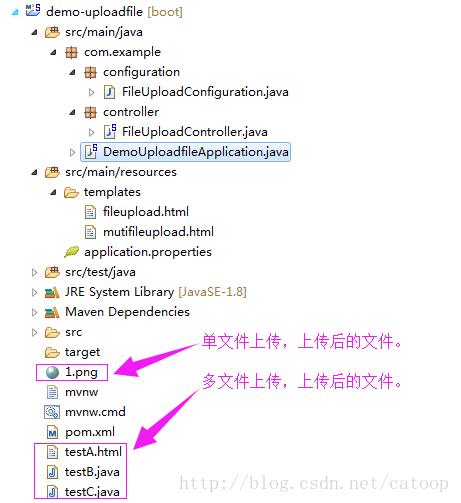使用SpringBoot进行文件上传的方法和SpringMVC差不多,本文单独新建一个最简单的DEMO来说明一下。
主要步骤包括:
1、创建一个springboot项目工程,本例名称(demo-uploadfile)。
2、配置 pom.xml 依赖。
3、创建和编写文件上传的 Controller(包含单文件上传和多文件上传)。
4、创建和编写文件上传的 HTML 测试页面。
5、文件上传相关限制的配置(可选)。
6、运行测试。
项目工程截图如下:

文件代码:
|
1
2
3
4
5
6
7
8
9
10
11
12
13
14
15
16
17
18
19
20
|
<dependencies> <!-- spring boot web支持 --> <dependency> <groupId>org.springframework.boot</groupId> <artifactId>spring-boot-starter-web</artifactId> </dependency> <!-- thmleaf模板依赖. --> <dependency> <groupId>org.springframework.boot</groupId> <artifactId>spring-boot-starter-thymeleaf</artifactId> </dependency> <dependency> <groupId>org.springframework.boot</groupId> <artifactId>spring-boot-starter-test</artifactId> <scope>test</scope> </dependency></dependencies> |
|
1
2
3
4
5
6
7
8
9
10
11
12
13
14
15
16
17
18
19
20
21
22
23
24
25
26
27
28
29
30
31
32
33
34
35
36
37
38
39
40
41
42
43
44
45
46
47
48
49
50
51
52
53
54
55
56
57
58
59
60
61
62
63
64
65
66
67
68
69
70
71
72
73
74
75
76
77
78
79
80
81
82
83
84
85
86
87
88
89
90
91
92
93
94
95
96
97
98
99
100
101
102
103
104
105
106
107
108
|
package com.example.controller;import java.io.BufferedOutputStream;import java.io.File;import java.io.FileNotFoundException;import java.io.FileOutputStream;import java.io.IOException;import java.util.List;import javax.servlet.http.HttpServletRequest;import org.springframework.stereotype.Controller;import org.springframework.web.bind.annotation.RequestMapping;import org.springframework.web.bind.annotation.RequestMethod;import org.springframework.web.bind.annotation.RequestParam;import org.springframework.web.bind.annotation.ResponseBody;import org.springframework.web.multipart.MultipartFile;import org.springframework.web.multipart.MultipartHttpServletRequest;/** * 文件上传的Controller * * @author 单红宇(CSDN CATOOP) * @create 2017年3月11日 */@Controllerpublic class FileUploadController { // 访问路径为:http://ip:port/upload @RequestMapping(value = "/upload", method = RequestMethod.GET) public String upload() { return "/fileupload"; } // 访问路径为:http://ip:port/upload/batch @RequestMapping(value = "/upload/batch", method = RequestMethod.GET) public String batchUpload() { return "/mutifileupload"; } /** * 文件上传具体实现方法(单文件上传) * * @param file * @return * * @author 单红宇(CSDN CATOOP) * @create 2017年3月11日 */ @RequestMapping(value = "/upload", method = RequestMethod.POST) @ResponseBody public String upload(@RequestParam("file") MultipartFile file) { if (!file.isEmpty()) { try { // 这里只是简单例子,文件直接输出到项目路径下。 // 实际项目中,文件需要输出到指定位置,需要在增加代码处理。 // 还有关于文件格式限制、文件大小限制,详见:中配置。 BufferedOutputStream out = new BufferedOutputStream( new FileOutputStream(new File(file.getOriginalFilename()))); out.write(file.getBytes()); out.flush(); out.close(); } catch (FileNotFoundException e) { e.printStackTrace(); return "上传失败," + e.getMessage(); } catch (IOException e) { e.printStackTrace(); return "上传失败," + e.getMessage(); } return "上传成功"; } else { return "上传失败,因为文件是空的."; } } /** * 多文件上传 主要是使用了MultipartHttpServletRequest和MultipartFile * * @param request * @return * * @author 单红宇(CSDN CATOOP) * @create 2017年3月11日 */ @RequestMapping(value = "/upload/batch", method = RequestMethod.POST) public @ResponseBody String batchUpload(HttpServletRequest request) { List<MultipartFile> files = ((MultipartHttpServletRequest) request).getFiles("file"); MultipartFile file = null; BufferedOutputStream stream = null; for (int i = 0; i < files.size(); ++i) { file = files.get(i); if (!file.isEmpty()) { try { byte[] bytes = file.getBytes(); stream = new BufferedOutputStream(new FileOutputStream(new File(file.getOriginalFilename()))); stream.write(bytes); stream.close(); } catch (Exception e) { stream = null; return "You failed to upload " + i + " => " + e.getMessage(); } } else { return "You failed to upload " + i + " because the file was empty."; } } return "upload successful"; }} |
|
1
2
3
4
5
6
7
8
9
10
11
12
13
14
15
16
17
18
19
20
21
22
23
24
25
26
27
28
|
package com.example.configuration;import javax.servlet.MultipartConfigElement;import org.springframework.boot.web.servlet.MultipartConfigFactory;import org.springframework.context.annotation.Bean;/** * 文件上传配置 * * @author 单红宇(CSDN CATOOP) * @create 2017年3月11日 */public class FileUploadConfiguration { @Bean public MultipartConfigElement multipartConfigElement() { MultipartConfigFactory factory = new MultipartConfigFactory(); // 设置文件大小限制 ,超出设置页面会抛出异常信息, // 这样在文件上传的地方就需要进行异常信息的处理了; factory.setMaxFileSize("256KB"); // KB,MB /// 设置总上传数据总大小 factory.setMaxRequestSize("512KB"); // Sets the directory location where files will be stored. // factory.setLocation("路径地址"); return factory.createMultipartConfig(); }} |
|
1
2
3
4
5
6
7
|
@SpringBootApplicationpublic class DemoUploadfileApplication { public static void main(String[] args) { SpringApplication.run(DemoUploadfileApplication.class, args); }} |
|
1
2
3
4
5
6
7
8
9
10
11
12
13
14
15
16
17
18
|
<!DOCTYPE html><html><head><title>文件上传示例</title></head><body> <h2>文件上传示例</h2> <hr/> <form method="POST" enctype="multipart/form-data" action="/upload"> <p> 文件:<input type="file" name="file" /> </p> <p> <input type="submit" value="上传" /> </p> </form></body></html> |
|
1
2
3
4
5
6
7
8
9
10
11
12
13
14
15
16
17
18
19
20
21
22
23
24
25
|
<!DOCTYPE html><html><head><title>批量文件上传示例</title></head><body> <h2>批量文件上传示例</h2> <hr/> <form method="POST" enctype="multipart/form-data" action="/upload/batch"> <p> 文件1:<input type="file" name="file" /> </p> <p> 文件2:<input type="file" name="file" /> </p> <p> 文件3:<input type="file" name="file" /> </p> <p> <input type="submit" value="上传" /> </p> </form></body></html> |
最后启动服务,访问 http://localhost:8080/upload 和 http://localhost:8080/upload/batch 测试文件上传。
Demo源代码下载地址:uploadfile.rar
以上就是本文的全部内容,希望对大家的学习有所帮助,也希望大家多多支持服务器之家。
原文链接:http://blog.csdn.net/catoop/article/details/61415169















